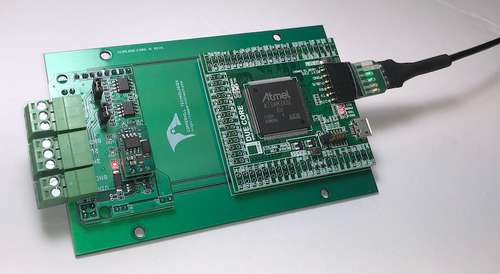Recent Posts
Multi-Protocol SoC With Two ARM Cortex-M4 Processor Cores Supports Two CAN Bus Controllers
Posted by on
Hilscher announced the release of their netX 90, an addition to its netX family of single-chip network controller ASICs. The netX 90 is the latest connectivity chip for slave devices. The chip addresses the fact that a large proportion of slave devices in use today will have to be replaced and/or updated if cyber risk threats are to be countered adequately for cloud-based and Industrial Internet of Things (IIoT) applications.
netX 90 is a dual processor chip with all the network connectivity common to Hilscher products, including firmware updating of protocols. It’s divided into two halves: RTE and fieldbus protocols are supported on the network-facing side while device-specific protocols (I/O, EnDat, Biss, and many other peripherals) are supported on the applications (slave-facing) side. In between are some common features such as on-chip diagnostics.
netX 90 comes with a full eco-system of development boards, accessories and software. JTAG developers’ kits are available and there’s an SoC solution called netRAPID 90 featuring netX 90 mounted on a small PCB, for direct embedding onto a motherboard.
- First Industrial Ethernet node in 10x10 mm2 with two ARM® Cortex®-M4 processor cores, on-chip Flash, analog/mixed signal, and integrated PHYs
- Fulfills the highest demand on flexibility, determinism, and performance in terms of multiprotocol capability and low latency for short cycle times
- Enables developers to implement a profound secure by design concept compliant to the IEC 62443 series for industrial automation security
- Improves the application design of high-reliable systems with built-in diagnostics and enhanced data integrity for IIoT-enabled services
- Support of two CAN Bus (2.0B, SJA1000) Controllers
More Information
- Download/View the netX 90 Industrial Communication SoC data sheet (PDF)...
- Download/View the netX 90 White Paper (PDF)...
- More Information...
Arduino-Due-Based USB Gateway With Two CAN Bus Ports
The Due Core is a compact version of the Arduino DUE. It integrates all peripherals required for the MCU, and all GPIO are connected to 2.54mm connectors. As a standard MCU core, the board has the following features:
- Compact size: All components are put on a 54 x 58mm 4-Layers PCB. All IOs are connected to a 116-pin 2.54 standard connector.
- Easy to use: All IOs are connected to 116pin 2.54 standard connector. It requires only a 5 VDC power supply to make it work.
- Stable design: High-quality 4-layer PCB layout, two 5V to 3.3V LDO onboard, one for digital and one for analog processing. Separate AVCC and AGND, to ensure optimum analog performance.
- Easy to set up the development environment: Uploading sketches through standard 6-pin UART interface, standard Micro usb connector, full use of existing resources.
- User-friendly design: Rich LED status indication, two onboard buttons, one is for MCU reset, and one is for Flash Erase. Unique jumper erase protection against the flash erased by mistake.
- Rich resources: All IOs are available for the user. The onboard I2C EEPROM is designed to compensate for the shortcomings of the standard SAM3X8E, which has no built-in EEPROM.
The jCOM.DUE.CORE-B board is powered either by the USB port connection (either the programming or native USB) or through an external power supply supporting an input voltage of 7 to 36 VDC.
 Loading... Please wait...
Loading... Please wait...


